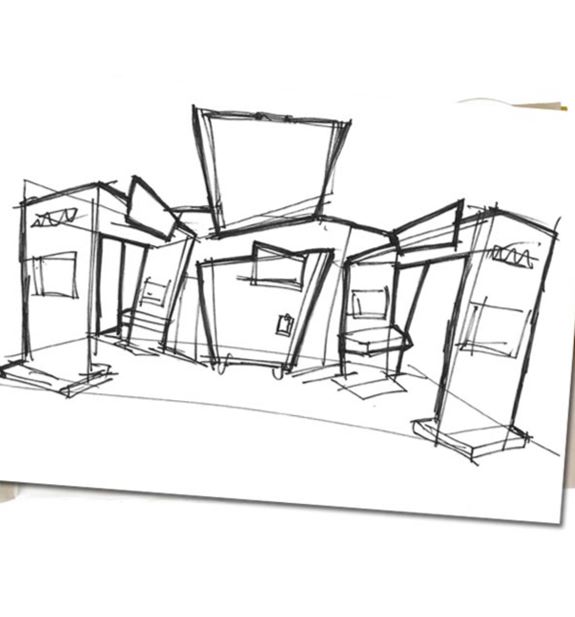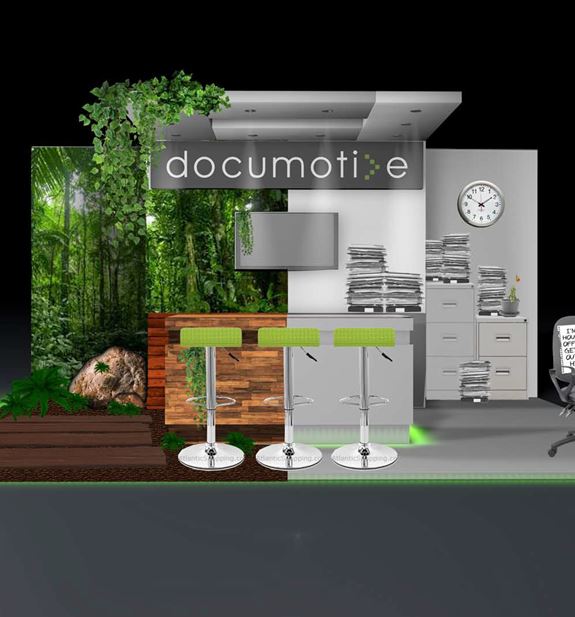
A design brief helps to focus your attention on key components for your exhibition stand and determine success criteria as well as identify other activities that will need to be included:
1. Background: Why? – The starting point for any activity is typically based upon business targets or objectives, so in a few sentences identify the key reasons for exhibiting, is it general brand awareness, a local trade show presence, the launch of a new product, or perhaps it is about educating an audience. Whatever the key reasons identified this will help in developing your exhibiting activities to derive an exhibition plan.
2. Objective/Desired outcome: What? - do you anticipate as the results from exhibiting? Objectives are crucial to a successful design brief as this provides you
with a key measurement to determine the success of your exhibition campaign. Everyone’s objectives will be different, from creating corporate brand awareness to launching new products or engaging with a targeted list of companies. Once you have identified your key objectives or outcomes, you now have a measurement that can be used to identify which events are suitable for you to exhibit at.
3. Audience: (Who are we talking to and what makes them tick?) Who? – It sounds simple to identify who you want to be talking to but it is important to remember that everyone is looking for something slightly different, who are your ideal prospects and what are they looking for? When exhibiting, it is crucial that you can deliver a message that will work for not only your target audience but also to others who may be able
to introduce you.
4. Key facts/Unique selling proposition: (What makes our offering different from
or better than our competitors?) Differentiating your business, product or services to others is a key ingredient in attracting people to you.
5. Primary Messages (What are we saying? What is the benefit of our offering?)
It is always important to remember that your audience is uneducated in terms of your proposition so the message must be clear and easily understood.
2. Objective/Desired outcome: What? - do you anticipate as the results from exhibiting? Objectives are crucial to a successful design brief as this provides you
with a key measurement to determine the success of your exhibition campaign. Everyone’s objectives will be different, from creating corporate brand awareness to launching new products or engaging with a targeted list of companies. Once you have identified your key objectives or outcomes, you now have a measurement that can be used to identify which events are suitable for you to exhibit at.
3. Audience: (Who are we talking to and what makes them tick?) Who? – It sounds simple to identify who you want to be talking to but it is important to remember that everyone is looking for something slightly different, who are your ideal prospects and what are they looking for? When exhibiting, it is crucial that you can deliver a message that will work for not only your target audience but also to others who may be able
to introduce you.
4. Key facts/Unique selling proposition: (What makes our offering different from
or better than our competitors?) Differentiating your business, product or services to others is a key ingredient in attracting people to you.
5. Primary Messages (What are we saying? What is the benefit of our offering?)
It is always important to remember that your audience is uneducated in terms of your proposition so the message must be clear and easily understood.

Make sure your design brief is clear and concise and you will turn the vision into reality
6. Promotion: a. Call to action: (What do you want the visitor to do?) Having attracted the visitor to your stand what do you want them to do? Take something away? Watch a demonstration?
b. Incentive: (if applicable)
7. Tone: (What is the best way to say it?) How are you to communicate with the visitor ? What do you want them to take away from your meeting, Innovative, Exciting, Trustworthy or Reliable or possibly necessity? The language and words used to promote your business is just as crucial in leaving an impression as the stand presence and presentation.
8. Mandatory features: What must the stand design and quote include?
When creating a stand brief you will need to clearly identify the elements that must form part of your stand design, whether this is a simple roller banner and desk presentation, a pop-up stand in a shell scheme or a custom designed and built stand, do you need Audio Visual equipment, lockable storage, seating areas or high table and stools ? Any component that needs to form part of your exhibition space needs to be identified and have a purpose.
9. Design references: What concept ideas do you have to promote your business? Do you want you exhibition stand to reflect your corporate marketing or web-site or does it need to reflect the environment in which you are working? As much information
as you can provide will help the designer encapsulate your vision.
10. Additional reference material:
(Related campaign, competitor information, translation considerations, URLs
and linked content, customer Journey, communication plan, physical product, CAD
files, etc.) Any other information that you can provide that will help in the development of your exhibition stand can only be beneficial.
11. Where will this be deployed? It is important to consider the exhibition space that you have, is the space open 1, 2 or 3 sides ? Are you looking to utilise the stand design more than once, if so where and when? Are the stand spaces the same size and configuration? With all of this information Your exhibition company partner will be able to work with you and effectively help in the promotion of your business.
12. Stakeholders: (Who must review drafts or final piece(s)?) Finally who are your business stakeholders? Who needs to be included in the approval process for your exhibition space.
b. Incentive: (if applicable)
7. Tone: (What is the best way to say it?) How are you to communicate with the visitor ? What do you want them to take away from your meeting, Innovative, Exciting, Trustworthy or Reliable or possibly necessity? The language and words used to promote your business is just as crucial in leaving an impression as the stand presence and presentation.
8. Mandatory features: What must the stand design and quote include?
When creating a stand brief you will need to clearly identify the elements that must form part of your stand design, whether this is a simple roller banner and desk presentation, a pop-up stand in a shell scheme or a custom designed and built stand, do you need Audio Visual equipment, lockable storage, seating areas or high table and stools ? Any component that needs to form part of your exhibition space needs to be identified and have a purpose.
9. Design references: What concept ideas do you have to promote your business? Do you want you exhibition stand to reflect your corporate marketing or web-site or does it need to reflect the environment in which you are working? As much information
as you can provide will help the designer encapsulate your vision.
10. Additional reference material:
(Related campaign, competitor information, translation considerations, URLs
and linked content, customer Journey, communication plan, physical product, CAD
files, etc.) Any other information that you can provide that will help in the development of your exhibition stand can only be beneficial.
11. Where will this be deployed? It is important to consider the exhibition space that you have, is the space open 1, 2 or 3 sides ? Are you looking to utilise the stand design more than once, if so where and when? Are the stand spaces the same size and configuration? With all of this information Your exhibition company partner will be able to work with you and effectively help in the promotion of your business.
12. Stakeholders: (Who must review drafts or final piece(s)?) Finally who are your business stakeholders? Who needs to be included in the approval process for your exhibition space.
CONTACT US TODAY
iDeal Displays have years of experience managing exhibition stand builds
and we provide this service for direct customers and on behalf of creative agencies. If you are considering exhibiting and want a stress free event just get in touch and let us manage it for you
and we provide this service for direct customers and on behalf of creative agencies. If you are considering exhibiting and want a stress free event just get in touch and let us manage it for you

